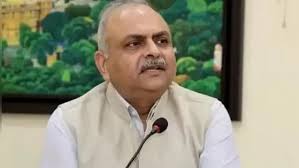As the economy grows, so would tax collection; hopeful of meeting FY26 target: CBDT Chairman Ravi Agrawal

India’s economy continues to grow, supported by strong domestic demand and robust corporate performance. CBDT Chairman Ravi Agrawal expressed confidence in meeting the direct tax collection target for FY26. He believes economic growth and better tax administration will drive the collection of ₹25.2 lakh crore this financial year.
Growth-Driven Tax Revenue
Agrawal stated that tax collections rise when the economy expands because businesses and individuals earn more. Direct tax collections have climbed steadily over the last decade. Better compliance and a broader taxpayer base have fueled this growth.
He admitted that collections slowed at the start of FY26 due to higher refunds and a postponed filing deadline. The deadline moved from July 31 to September 15. Agrawal stressed that these delays are temporary. He expects tax inflows to improve later in the fiscal year as GDP growth remains strong.
Strengthening Compliance Through Technology
The CBDT uses technology and AI to improve compliance and spot irregularities. Agrawal explained that nudge-based campaigns push taxpayers to correct errors in their filings.
This softer approach has delivered results. About 1.1 crore updated returns brought in over ₹11,000 crore in extra taxes. Agrawal said that the department’s focus is encouraging voluntary compliance rather than relying solely on enforcement.
AI-Powered Data Analytics
CBDT’s AI-driven risk analysis detects high-value transactions and mismatches between income and spending. When anomalies appear, the system sends “soft nudges” to taxpayers. If they fail to respond, the department escalates to stricter notices.
Between April 2023 and June 2025, these campaigns led to ₹963 crore in withdrawn claims and ₹409.5 crore in additional taxes. Technology is now central to reducing tax evasion and making compliance seamless.
Widening the Taxpayer Base
India’s taxpayer base has grown rapidly. It expanded from 30 million in FY14 to 90 million in FY25. This increase is due to digital initiatives like pre-filled forms, real-time data updates, and easy online filing.
The CBDT uses data analytics to identify potential taxpayers who have taxable income but haven’t filed returns. By engaging with them early, the department has successfully closed compliance gaps and raised revenues.
Preparing for a New Tax Regime
Agrawal’s optimism aligns with the government’s plan to introduce a new direct tax law. The CBDT is finalizing the rules and forms to simplify the tax system and improve transparency.
The new regime will be taxpayer-friendly and technology-driven. Agrawal described this approach as “enforcement with empathy.” The department will continue using data and AI but will focus on making compliance easier for honest taxpayers.
Challenges and Opportunities
Agrawal pointed out that challenges remain. Global uncertainties, commodity price swings, and geopolitical risks may affect economic growth. Bringing the informal sector into the tax net also remains a major task.
However, domestic consumption and corporate earnings remain strong. Government-led capital spending will further support economic momentum. Agrawal believes these factors will sustain tax collection growth in the coming years.
Outlook for FY26
Agrawal confirmed that the CBDT is on track to meet the ₹25.2 lakh crore target. Economic growth, AI-driven monitoring, and wider compliance will ensure steady revenue inflows.
His comments reflect confidence in both the Indian economy’s resilience and the success of ongoing tax reforms. With digitization and better engagement, India is moving towards a modern and transparent tax ecosystem.ffectiveness of ongoing tax reforms. As India moves towards a more digitized and inclusive tax system, the focus will remain on building trust with taxpayers while leveraging technology to enhance efficiency.






